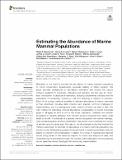Files in this item
Estimating the abundance of marine mammal populations
Item metadata
| dc.contributor.author | Hammond, Philip S. | |
| dc.contributor.author | Francis, Tessa B. | |
| dc.contributor.author | Heinemann, Dennis | |
| dc.contributor.author | Long, Kristy J. | |
| dc.contributor.author | Moore, Jeffrey E. | |
| dc.contributor.author | Punt, André E. | |
| dc.contributor.author | Reeves, Randall R. | |
| dc.contributor.author | Sepúlveda, Maritza | |
| dc.contributor.author | Sigurðsson, Guðjón Már | |
| dc.contributor.author | Siple, Margaret C. | |
| dc.contributor.author | Víkingsson, Gísli | |
| dc.contributor.author | Wade, Paul R. | |
| dc.contributor.author | Williams, Rob | |
| dc.contributor.author | Zerbini, Alexandre N. | |
| dc.date.accessioned | 2021-10-11T11:30:07Z | |
| dc.date.available | 2021-10-11T11:30:07Z | |
| dc.date.issued | 2021-09-27 | |
| dc.identifier.citation | Hammond , P S , Francis , T B , Heinemann , D , Long , K J , Moore , J E , Punt , A E , Reeves , R R , Sepúlveda , M , Sigurðsson , G M , Siple , M C , Víkingsson , G , Wade , P R , Williams , R & Zerbini , A N 2021 , ' Estimating the abundance of marine mammal populations ' , Frontiers in Marine Science , vol. 8 , 735770 . https://doi.org/10.3389/fmars.2021.735770 | en |
| dc.identifier.issn | 2296-7745 | |
| dc.identifier.other | PURE: 276240130 | |
| dc.identifier.other | PURE UUID: e38a49e9-3e19-44f0-93f0-fa81bcd72702 | |
| dc.identifier.other | Jisc: 3f9446c73a214e02aa8e4ffb82209f60 | |
| dc.identifier.other | Scopus: 85116945812 | |
| dc.identifier.other | WOS: 000705503700001 | |
| dc.identifier.uri | https://hdl.handle.net/10023/24107 | |
| dc.description | Support for this project was provided by the Lenfest Ocean Program. | en |
| dc.description.abstract | Motivated by the need to estimate the abundance of marine mammal populations to inform conservation assessments, especially relating to fishery bycatch, this paper provides background on abundance estimation and reviews the various methods available for pinnipeds, cetaceans and sirenians. We first give an “entry-level” introduction to abundance estimation, including fundamental concepts and the importance of recognizing sources of bias and obtaining a measure of precision. Each of the primary methods available to estimate abundance of marine mammals is then described, including data collection and analysis, common challenges in implementation, and the assumptions made, violation of which can lead to bias. The main method for estimating pinniped abundance is extrapolation of counts of animals (pups or all-ages) on land or ice to the whole population. Cetacean and sirenian abundance is primarily estimated from transect surveys conducted from ships, small boats or aircraft. If individuals of a species can be recognized from natural markings, mark-recapture analysis of photo-identification data can be used to estimate the number of animals using the study area. Throughout, we cite example studies that illustrate the methods described. To estimate the abundance of a marine mammal population, key issues include: defining the population to be estimated, considering candidate methods based on strengths and weaknesses in relation to a range of logistical and practical issues, being aware of the resources required to collect and analyze the data, and understanding the assumptions made. We conclude with a discussion of some practical issues, given the various challenges that arise during implementation. | |
| dc.format.extent | 27 | |
| dc.language.iso | eng | |
| dc.relation.ispartof | Frontiers in Marine Science | en |
| dc.rights | Copyright © 2021 Hammond, Francis, Heinemann, Long, Moore, Punt, Reeves, Sepúlveda, Sigurðsson, Siple, Víkingsson, Wade, Williams and Zerbini. This is an open-access article distributed under the terms of the Creative Commons Attribution License (CC BY). The use, distribution or reproduction in other forums is permitted, provided the original author(s) and the copyright owner(s) are credited and that the original publication in this journal is cited, in accordance with accepted academic practice. No use, distribution or reproduction is permitted which does not comply with these terms. | en |
| dc.subject | Marine Science | en |
| dc.subject | Abundance | en |
| dc.subject | Cetaceans | en |
| dc.subject | Pinnipeds | en |
| dc.subject | Sirenians | en |
| dc.subject | Population size | en |
| dc.subject | GC Oceanography | en |
| dc.subject | QH301 Biology | en |
| dc.subject | SDG 14 - Life Below Water | en |
| dc.subject.lcc | GC | en |
| dc.subject.lcc | QH301 | en |
| dc.title | Estimating the abundance of marine mammal populations | en |
| dc.type | Journal item | en |
| dc.description.version | Publisher PDF | en |
| dc.contributor.institution | University of St Andrews. School of Biology | en |
| dc.contributor.institution | University of St Andrews. Sea Mammal Research Unit | en |
| dc.contributor.institution | University of St Andrews. Scottish Oceans Institute | en |
| dc.contributor.institution | University of St Andrews. Centre for Research into Ecological & Environmental Modelling | en |
| dc.contributor.institution | University of St Andrews. Marine Alliance for Science & Technology Scotland | en |
| dc.identifier.doi | https://doi.org/10.3389/fmars.2021.735770 | |
| dc.description.status | Peer reviewed | en |
This item appears in the following Collection(s)
Items in the St Andrews Research Repository are protected by copyright, with all rights reserved, unless otherwise indicated.

